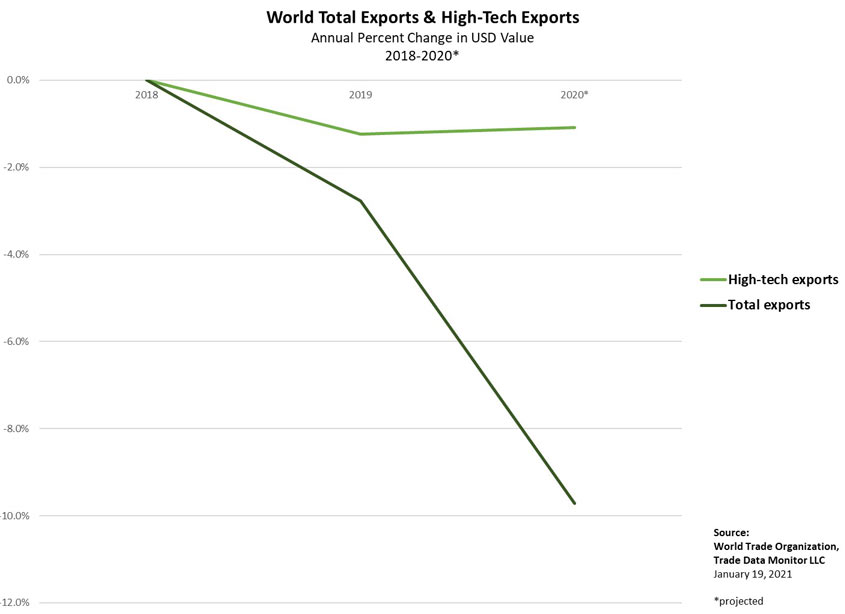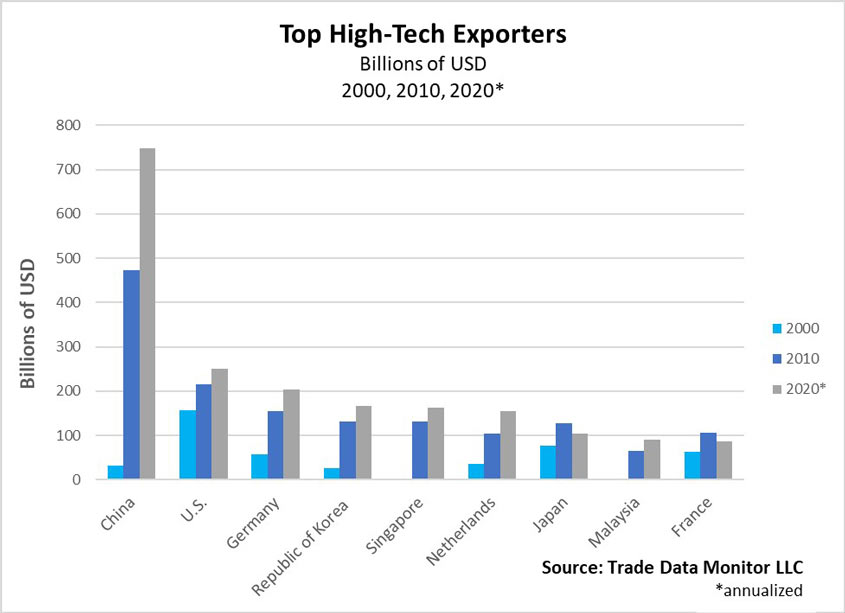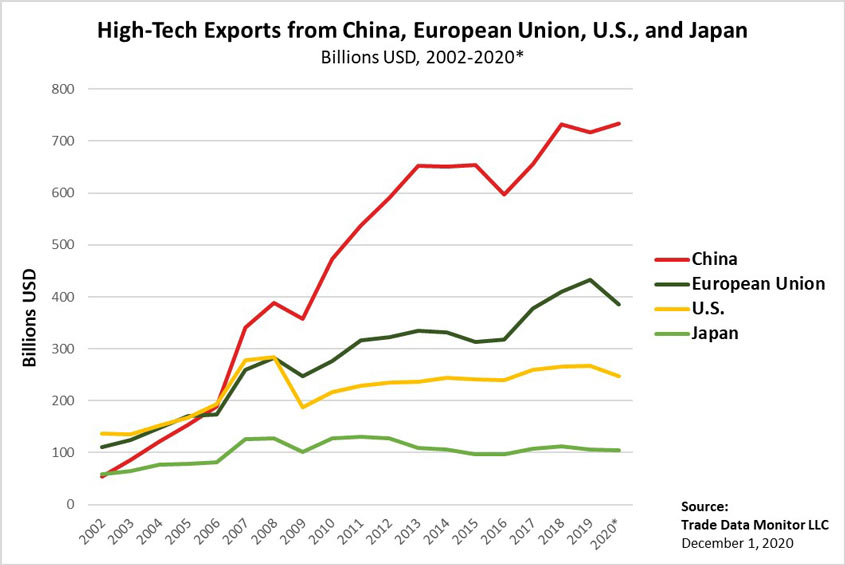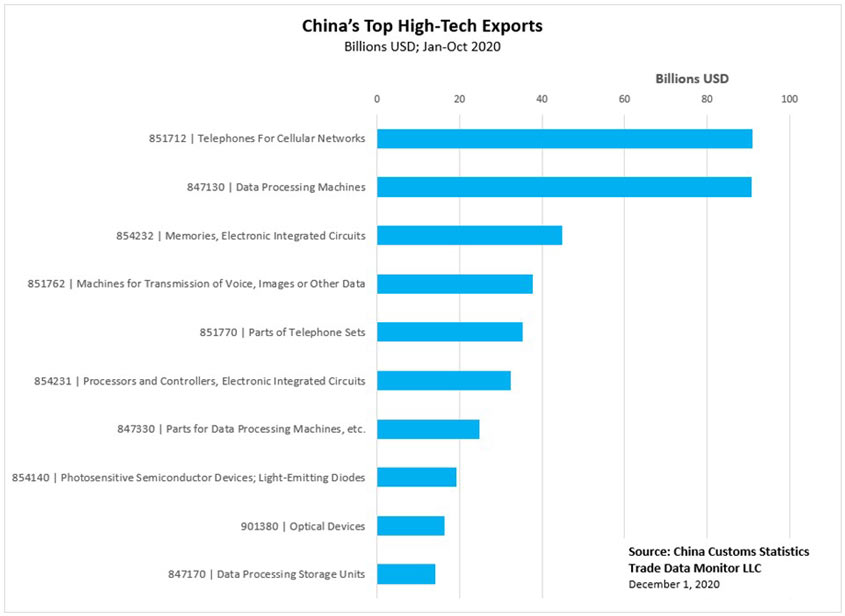In 2020, global trade faced headwinds mainly caused by the COVID-19-related economic standstill. In September 2020, the WIPO Global Innovation Index noted the risk of a potentially sharp downward impact of the pandemic crisis on technology-related investment and trade.

But as our new estimates show, 2020 trade in high-tech goods outperformed goods trade, thanks to a boom in communications, computing, processing and data storage equipment geared toward remote and mobile work. In addition, this trend is continuing in early 2021.
Thanks to a strong second half following a difficult spring, total high-tech trade is expected to decline only about 1% as compared to 2019 and to USD3.36 trillion in 2020, according to a projection by Trade Data Monitor.
By comparison, total merchandise trade fell by 9.2% to USD17.1 trillion in 2020 from USD18.9 trillion in 2019, as the global economy slowed down, especially the transport and construction sectors.

World Total Exports & High-Tech Exports
At its root, the resilience of 2020 tech trade was driven by broad changes in consumer behavior in the world’s top economies. Overall, high-tech trade mirrored trends in other goods, shaped by more people working from home. For that reason, trade in shoes, luggage and petroleum suffered while shipments of furniture, exercise equipment, and toys rebounded quickly in 2020.
The United States of America (U.S.), for example, increased imports of tablets and laptops 20.9% to USD45.2 billion in the first 11 months of 2020. The U.S. ramped up imports of solid-state semiconductor storage devices, used for cloud computing, 38.4% to USD12.3 billon.
China was the world’s top exporter of high-tech goods in the first 10 months of 2020, followed by the European Union (EU) (USD316.1 billion), U.S. (USD207.4 billion), and the Republic of Korea (USD137.8 billion).

Businesses adjusted to working through COVID-19
The COVID-19 pandemic which ravaged the world in 2020 damaged high-tech supply chains in the spring by forcing factory closures, slowing down shipping lines and hurting consumer demand. It looked like global business was facing an existential threat.
As the year went on, however, manufacturers and logistics managers figured out how make their businesses work. Sales rebounded in the summer and autumn as demand picked up, also thanks to robust sales of work-from-home technology.
In March, exports by the world’s top high-tech manufacturer, China, sank to USD54.5 billion, down 8.1% from USD59.3 billion in March of 2019. Shipments to the U.S. from China fell 21.7% to USD7.5 billion in March. The collapse was across the board: In March, exports of phones decreased 7.8% to USD8.4 billion, data processing machines down 14.3% to USD6.9 billion, and routers minus 12.9% to USD3.2 billion.
Then China was the first country to absorb the impact of COVID-19 and to drive high-tech exports up again.

High-Tech Exports from China, European Union, U.S. and Japan
COVID-19 accelerates China’s rise
By April, Chinese high-tech exports had increased 10.1% year-on-year to USD59.7 billion. The momentum continued: In November, Chinese high-tech exports increased a strong 21.1% year-on-year to USD86.1 billion further cementing its high-tech trade lead
In 2000, the U.S. was the world’s number one tech exporter, shipping out USD156.9 billion. China was far down, in eighth place at USD31.9 billion. By 2010, China was tops in the world, with USD472.6 billion of exports.
In 2020, China’s high-tech trade exports are expected to amount to USD733.4 billion, up 2.3% from USD716.6 billion in 2019, and more than 20 times the value of its shipments in 2000, USD31.9 billion.
China’s top high-tech export categories in the first 11 months of 2020 were phones (USD111.7 billion), data processing machines (USD102.7 billion), integrated circuits (USD50.3 billion), routers (USD43.1 billion), and phone parts and technology (USD40.2 billion).

China's Top High-Tech Exports
U.S. consumers drive demand for high-tech goods
The U.S. is the world’s second largest import of high-tech goods, after only China, which imports large amounts of parts for supply chains. In 2019, the U.S. imported USD505.2 billion of high-tech goods, up from USD473.5 billion in 2018.
U.S. demand was damaged by the coronavirus pandemic. In April, U.S. imports declined 9.7% month-on-month to USD36 billion from USD39.8 billion in April 2019. But buying picked up during the rest of the year: In the first 11 months of 2020, it imported USD457.3 billion, up 0.1% year-on-year.
Trade data from 2020 suggests that U.S. buyers are changing where they source high-tech gear. Over the first 11 months, imports from China fell 3.6% to USD126.5 billion, while those from Viet Nam increased 24.1% to USD24.7 billion, and those from the Republic of Korea rose 9% to USD18.2 billion.
Viet Nam leads rise of other Asian countries
Next to China, and due to various factors, other Asian countries are gaining ground as key sources of manufactured technology goods, a trend that should continue in 2021. The trend has benefited Malaysia, Thailand, Singapore and the Republic of Korea, but the real beneficiary of this Asian renaissance is Viet Nam.
In the first 11 months of 2020, China imported USD36.8 billion of high-tech goods from Viet Nam, up 35.4% from the same period of 2019, including billions of sales in phones, routers, processors, circuits and semiconductors.
Overall, Viet Nam trading partners reported importing USD95.7 billion of high-tech goods in the first nine months of 2020, up from USD70.5 billion in 2016.
Outlook for 2021
The World Trade Organization has predicted a 7.2% rebound in global trade in 2021. Based on the surge in the second half of 2020, it is estimated that global high-tech trade will again keep pace with or outperform overall goods trade in 2021.
About Trade Data Monitor
Based in Geneva, Switzerland and Charleston, South Carolina, Trade Data Monitor specializes in providing data for economic and development research conducted by organizations such as the WTO, the FAO, and the WIPO Global Innovation Index. TDM procures data from national governments around the world, and assembles it, monthly instead of annually, in easy-to-read charts and interfaces. Governments, international organizations, and private companies use TDM to keep track of market trends by accessing accurate timely imports and exports statistics for over a hundred countries. Consistently, TDM revises and adjusts data to ensure its accuracy, double checking it with customs data.
WIPO
https://www.wipo.int/pressroom/en/news/2021/news_0001.html